C H A P T E R
Parallel Computation
Parallelism takes many forms and appears in many guises. It is exhibited at the CPU level when
microinstructions are executed simultaneously. It is also present when an arithmetic or logic
operation is realized by a circuit of small depth, as with carry-save addition. And it is present
when multiple computers are connected together in a network. Parallelism can be available but
go unused, either because an application was not designed to exploit parallelism or because a
problem is inherently serial.
In this chapter we examine a number of explicitly parallel models of computation, includ-
ing shared and distributed memory models and, in particular, linear and multidimensional
arrays, hypercube-based machines, and the PRAM model. We give a broad introduction to
a large and representative set of models, describing a handful of good parallel programming
techniques and showing through analysis the limits on parallelization. Because of the limited
use so far of parallel algorithms and machines, the wide range of hardware and software models
developed by the research community has not yet been fully digested by the computer industry.
Parallelism in logic and algebraic circuits is also examined in Chapters 2 and 6. The block
I/O model, which characterizes parallelism at the disk level, is presented in Section 11.6 and
the classification of problems by their execution time on parallel machines is discussed in Sec-
tion 8.15.2.
281
�
282
Chapter 7 Parallel Computation
Models of Computation
7.1 Parallel Computational Models
A parallel computer is any computer that can perform more than one operation at time.
By this definition almost every computer is a parallel computer. For example, in the pursuit
of speed, computer architects regularly perform multiple operations in each CPU cycle: they
execute several microinstructions per cycle and overlap input and output operations (I/O) (see
Chapter 11) with arithmetic and logical operations. Architects also design parallel computers
that are either several CPU and memory units attached to a common bus or a collection of
computers connected together via a network. Clearly parallelism is common in computer
science today.
However, several decades of research have shown that exploiting large-scale parallelism is
very hard. Standard algorithmic techniques and their corresponding data structures do not
parallelize well, necessitating the development of new methods. In addition, when parallelism
is sought through the undisciplined coordination of a large number of tasks, the sheer number
of simultaneous activities to which one human mind must attend can be so large that it is
often difficult to insure correctness of a program design. The problems of parallelism are
indeed daunting.
Small illustrations of this point are seen in Section 2.7.1, which presents an O(log n)-step,
O(n)-gate addition circuit that is considerably more complex than the ripple adder given in
Section 2.7. Similarly, the fast matrix inversion straight-line algorithm of Section 6.5.5 is more
complex than other such algorithms (see Section 6.5).
In this chapter we examine forms of parallelism that are more coarse-grained than is typ-
ically found in circuits. We assume that a parallel computer consists of multiple processors
and memories but that each processor is primarily serial. That is, although a processor may
realize its instructions with parallel circuits, it typically executes only one or a small number of
instructions simultaneously. Thus, most of the parallelism exhibited by our parallel computer
is due to parallel execution by its processors.
We also describe a few programming styles that encourage a parallel style of programming
and offer promise for user acceptance. Finally, we present various methods of analysis that
have proven useful in either determining the parallel time needed for a problem or classifying
a problem according to its need for parallel time.
Given the doubling of CPU speed every two or three years, one may ask whether we can’t
just wait until CPU performance catches up with demand. Unfortunately, the appetite for
speed grows faster than increases in CPU speed alone can meet. Today many problems, es-
pecially those involving simulation of physical systems, require teraflop computers (those per-
forming 1012 floating-point operations per second (FLOPS)) but it is predicted that petaflop
computers (performing 1015 FLOPS) are needed. Achieving such high levels of performance
with a handful of CPUs may require CPU performance beyond what is physically possible at
reasonable prices.
7.2 Memoryless Parallel Computers
The circuit is the premier parallel memoryless computational model: input data passes through
a circuit from inputs to outputs and disappears. A circuit is described by a directed acyclic
graph in which vertices are either input or computational vertices. Input values and the re-
sults of computations are drawn from a set associated with the circuit. (In the case of logic
�
c!John E Savage
7.3 Parallel Computers with Memory
283
9
f+, ω0
10
11
f+, ω2
f+, ω1
f+, ω3
12
cj+1
sj
gj
pj
vj
uj
cj
5
f+, ω0
6
f+, ω2
7
f+, ω2
f+, ω0
1
2
3
a0
a2
a1
a3
8
4
(a)
(b)
Figure 7.1 Examples of Boolean and algebraic circuits.
circuits, these values are drawn from the set B = {0, 1} and are called Boolean.) The function
computed at a vertex is defined through functional composition with values associated with
computational and input vertices on which the vertex depends. Boolean logic circuits are dis-
cussed at length in Chapters 2 and 9. Algebraic and combinatorial circuits are the subject of
Chapter 6. (See Fig. 7.1.)
A circuit is a form of unstructured parallel computer. No order or structure is assumed
on the operations that are performed. (Of course, this does not prevent structure from being
imposed on a circuit.) Generally circuits are a form of fine-grained parallel computer; that
is, they typically perform low-level operations, such as AND, OR, or NOT in the case of logic
circuits, or addition and multiplication in the case of algebraic circuits. However, if the set
of values on which circuits operate is rich, the corresponding operations can be complex and
coarse-grained.
The dataflow computer is a parallel computer designed to simulate a circuit computation.
It maintains a list of operations and, when all operands of an operation have been computed,
places that operation on a queue of runnable jobs.
We now examine a variety of structured computational models, most of which are coarse-
grained and synchronous.
7.3 Parallel Computers with Memory
Many coarse-grained, structured parallel computational models have been developed. In this
section we introduce these models as well as a variety of performance measures for parallel
computers.
�
284
Chapter 7 Parallel Computation
Models of Computation
There are many ways to characterize parallel computers. A fine-grained parallel computer
is one in which the focus is on its constituent components, which themselves consist of low-
level entities such as logic gates and binary memory cells. A coarse-grained parallel computer
is one in which we ignore the low-level components of the computer and focus instead on its
functioning at a high level. A complex circuit, such as a carry-lookahead adder, whose details
are ignored is a single coarse-grained unit, whereas one whose details are studied explicitly is
fine-grained. CPUs and large memory units are generally viewed as coarse-grained.
A parallel computer is a collection of interconnected processors (CPUs or memories). The
processors and the media used to connect them constitute a network. If the processors are
in close physical proximity and can communicate quickly, we often say that they are tightly
coupled and call the machine a parallel computer rather than a computer network. How-
ever, when the processors are not in close proximity or when their operating systems require a
large amount of time to exchange messages, we say that they are loosely coupled and call the
machine a computer network.
Unless a problem is trivially parallel, it must be possible to exchange messages between
processors. A variety of low-level mechanisms are generally available for this purpose. The use
of software for the exchange of potentially long messages is called message passing. In a tightly
coupled parallel computer, messages are prepared, sent, and received quickly relative to the
clock speed of its processors, but in a loosely coupled parallel computer, the time required for
these steps is much larger. The time Tm to transmit a message from one processor to another
is generally assumed to be of the form Tm = α + lβ, where l is the length of the message in
words, α (latency) is the time to set up a communication channel, and β (bandwidth) is the
time to send and receive one word. Both α and β are constant multiples of the duration of
the CPU clock cycle of the processors. Thus, α + β is the time to prepare, send, and receive
a single-word message. In a tightly coupled machine α and β are small, whereas in a loosely
coupled machine α is large.
An important classification of parallel computers with memory is based on the degree to
which they share access to memory. A shared-memory computer is characterized by a model
in which each processor can address locations in a common memory. (See Fig. 7.2(a).) In
this model it is generally assumed that the time to make one access to the common mem-
Mp
Pp
...
M3
P3
Common Memory
Network
P1
P2
...
Pp
M1
P1
M2
P2
(a)
(b)
Figure 7.2 (a) A shared-memory computer; (b) a distributed-memory computer.
�
c!John E Savage
7.3 Parallel Computers with Memory
285
ory is relatively close to the time for a processor to access one of its registers. Processors in a
shared-memory computer can communicate with one another via the common memory. The
distributed-memory computer is characterized by a model in which processors can commu-
nicate with other processors only by sending messages. (See Fig. 7.2(b).) In this model it is
generally assumed that processors also have local memories and that the time to send a message
from one processor to another can be large relative to the time to access a local memory. A third
type of computer, a cross between the first two, is the distributed shared-memory computer.
It is realized on a distributed-memory computer on which the time to process messages is large
relative to the time to access a local memory, but a layer of software gives the programmer the
illusion of a shared-memory computer. Such a model is useful when programs can be executed
primarily from local memories and only occasionally must access remote memories.
Parallel computers are synchronous if all processors perform operations in lockstep and
asynchronous otherwise. A synchronous parallel machine may alternate between executing
instructions and reading from local or common memory.
(See the PRAM model of Sec-
tion 7.9, which is a synchronous, shared-memory model.) Although a synchronous parallel
computational model is useful in conveying concepts, in many situations, as with loosely cou-
pled distributed computers, it is not a realistic one. In other situations, such as in the design
of VLSI chips, it is realistic. (See, for example, the discussion of systolic arrays in Section 7.5.)
7.3.1 Flynn’s Taxonomy
Flynn’s taxonomy of parallel computers distinguishes between four extreme types of paral-
lel machine on the basis of the degree of simultaneity in their handling of instructions and
data. The single-instruction, single-data (SISD) model is a serial machine that executes one
instruction per unit time on one data item. An SISD machine is the simplest form of serial
computer. The single-instruction, multiple-data (SIMD) model is a synchronous parallel
machine in which all processors that are not idle execute the same instruction on potentially
different data.
(See Fig. 7.3.) The multiple-instruction, single-data (MISD) model de-
scribes a synchronous parallel machine that performs different computations on the same data.
While not yet practical, the MISD machine could be used to test the primality of an inte-
ger (the single datum) by having processors divide it by independent sets of integers. The
Common Memory
P1
P2
...
Pp
Control Unit
Figure 7.3 In the SIMD model the same instruction is executed on every processor that is
not idle.
�
286
Chapter 7 Parallel Computation
Models of Computation
multiple-instruction, multiple-data (MIMD) model describes a parallel machine that runs
a potentially different program on potentially different data on each processor but can send
messages among processors.
The SIMD machine is generally designed to have a single instruction decoder unit that
controls the action of each processor, as suggested in Fig. 7.3. SIMD machines have not been a
commercial success because they require specialized processors rather than today’s commodity
processors that benefit from economies of scale. As a result, most parallel machines today are
MIMD. Nonetheless, the SIMD style of programming remains appealing because programs
having a single thread of control are much easier to code and debug. In addition, a MIMD
model, the more common parallel model in use today, can be programmed in a SIMD style.
While the MIMD model is often assumed to be much more powerful than the SIMD
one, we now show that the former can be converted to the latter with at most a constant
factor slowdown in execution time. Let K be the maximum number of different instructions
executable by a MIMD machine and index them with integers in the set {1, 2, 3, . . . , K}.
Slow down the computation of each machine by a factor K as follows: 1) identify time intervals
of length K, 2) on the kth step of the jth interval, execute the kth instruction of a processor if
this is the instruction that it would have performed on the jth step of the original computation.
Otherwise, let the processor be idle by executing its NOOP instruction. This construction
executes the instructions of a MIMD computation in a SIMD fashion (all processors either
are idle or execute the instruction with the same index) with a slowdown by a factor K in
execution time.
Although for most machines this simulation is impractical, it does demonstrate that in the
best case a SIMD program is at worst a constant factor slower than the corresponding MIMD
program for the same problem. It offers hope that the much simpler SIMD programming style
can be made close in performance to the more difficult MIMD style.
7.3.2 The Data-Parallel Model
The data-parallel model captures the essential features of the SIMD style. It has a single
thread of control in which serial and parallel operations are intermixed. The parallel opera-
tions possible typically include vector and shifting operations (see Section 2.5.1), prefix and
segmented prefix computations (see Sections 2.6), and data-movement operations such as are
realized by a permutation network (see Section 7.8.1). They also include conditional vector
operations, vector operations that are performed on those vector components for which the
corresponding component of an auxiliary flag vector has value 1 (others have value 0).
Figure 7.4 shows a data-parallel program for radix sort. This program sorts n d-bit inte-
gers, {x[n], . . . , x[1]}, represented in binary. The program makes d passes over the integers.
On each pass the program reorders the integers, placing those whose jth least significant bit
(lsb) is 1 ahead of those for which it is 0. This reordering is stable; that is, the previous or-
dering among integers with the same jth lsb is retained. After the jth pass, the n integers are
sorted according to their j least significant bits, so that after d passes the list is fully sorted.
The prefix function P (n)
+ computes the running sum of the jth lsb on the jth pass. Thus, for
k such that x[k]j = 1 (0), bk (ck) is the number of integers with index k or higher whose
jth lsb is 1 (0). The value of ak = bkx[k]j + (ck + b1)x[k]j is bk or ck + b1, depending on
whether the lsb of x[k] is 1 or 0, respectively. That is, ak is the index of the location in which
the kth integer is placed after the jth pass.
�
7.3 Parallel Computers with Memory
c!John E Savage
{ x[n]j is the jth least significant bit of the nth integer. }
{ After the jth pass, the integers are sorted by their j least significant bits. }
{ Upon completion, the kth location contains the kth largest integer. }
for j := 0 to d − 1
begin
287
(bn, . . . , b1) := P (n)
+ (x[n]j, . . . , x[1]j);
{ bk is the number of 1’s among x[n]j, . . . , x[k]j. }
{ b1 is the number of integers whose jth bit is 1. }
+ (x[n]j, . . . , x[1]j);
{ ck is the number of 0’s among x[n]j, . . ., x[k]j. }
(cn, . . . , c1) := P (n)
(an, . . . , a1) :=!bnx[n]j + (cn + b1)x[n]j, . . . , b1x[1]j + (c1 + b1)x[1]j";
{ ak = bkx[k]j + (ck + b1)x[k]j is the rank of the kth key. }
(x[n + 1 − an], x[n + 1 − an−1], . . . , x[n + 1 − a1]) := (x[n], x[n − 1], . . . , x[1])
{ This operation permutes the integers. }
end
Figure 7.4 A data-parallel radix sorting program to sort n d-bit binary integers that makes two
uses of the prefix function P (n)
+ .
The data-parallel model is often implemented using the single-program multiple-data
(SPMD) model. This model allows copies of one program to run on multiple processors with
potentially different data without requiring that the copies run in synchrony. It also allows
the copies to synchronize themselves periodically for the transfer of data. A convenient ab-
straction often used in the data-parallel model that translates nicely to the SPMD model is the
assumption that a collection of virtual processors is available, one per vector component. An
operating system then maps these virtual processors to physical ones. This method is effective
when there are many more virtual processors than real ones so that the time for interprocessor
communication is amortized.
7.3.3 Networked Computers
A networked computer consists of a collection of processors with direct connections between
them. In this context a processor is a CPU with memory or a sequential machine designed
to route messages between processors. The graph of a network has a vertex associated with
each processor and an edge between two connected processors. Properties of the graph of a
network, such as its size (number of vertices), its diameter (the largest number of edges on
the shortest path between two vertices), and its bisection width (the smallest number of edges
between a subgraph and its complement, both of which have about the same size) characterize
its computational performance. Since a transmission over an edge of a network introduces
delay, the diameter of a network graph is a crude measure of the worst-case time to transmit
�
288
Chapter 7 Parallel Computation
Models of Computation
(a)
(b)
Figure 7.5 Completely balanced (a) and unbalanced (b) trees.
a message between processors. Its bisection width is a measure of the amount of information
that must be transmitted in the network for processors to communicate with their neighbors.
A large variety of networks have been investigated. The graph of a tree network is a tree.
Many simple tasks, such as computing sums and broadcasting (sending a message from one
processor to all other processors), can be done on tree networks. Trees are also naturally suited
to many recursive computations that are characterized by divide-and-conquer strategies, in
which a problem is divided into a number of like problems of similar size to yield small results
that can be combined to produce a solution to the original problem. Trees can be completely
balanced or unbalanced. (See Fig. 7.5.) Balanced trees of fixed degree have a root and bounded
number of edges associated with each vertex. The diameter of such trees is logarithmic in
the number of vertices. Unbalanced trees can have a diameter that is linear in the number of
vertices.
A mesh is a regular graph (see Section 7.5) in which each vertex has the same degree except
possibly for vertices on its boundary. Meshes are well suited to matrix operations and can be
used for a large variety of other problems as well. If, as some believe, speed-of-light limitations
will be an important consideration in constructing fast computers in the future [43], the one-,
two-, and three-dimensional mesh may very well become the computer organization of choice.
The diameter of a mesh of dimension d with n vertices is proportional to n1/d. It is not as
small as the diameter of a tree but acceptable for tasks for which the cost of communication
can be amortized over the cost of computation.
The hypercube (see Section 7.6) is a graph that has one vertex at each corner of a mul-
tidimensional cube.
It is an important conceptual model because it has low (logarithmic)
diameter, large bisection width, and a connectivity for which it is easy to construct efficient
parallel algorithms for a large variety of problems. While the hypercube and the tree have sim-
ilar diameters, the superior connectivity of the hypercube leads to algorithms whose running
time is generally smaller than on trees. Fortunately, many hypercube-based algorithms can be
efficiently translated into algorithms for other network graphs, such as meshes.
We demonstrate the utility of each of the above models by providing algorithms that are
naturally suited to them. For example, linear arrays are good at performing matrix-vector
multiplications and sorting with bubble sort. Two-dimensional meshes are good at matrix-
matrix multiplication, and can also be used to sort in much less time than linear arrays. The
hypercube network is very good at solving a variety of problems quickly but is much more
expensive to realize than linear or two-dimensional meshes because each processor is connected
to many more other processors.
�
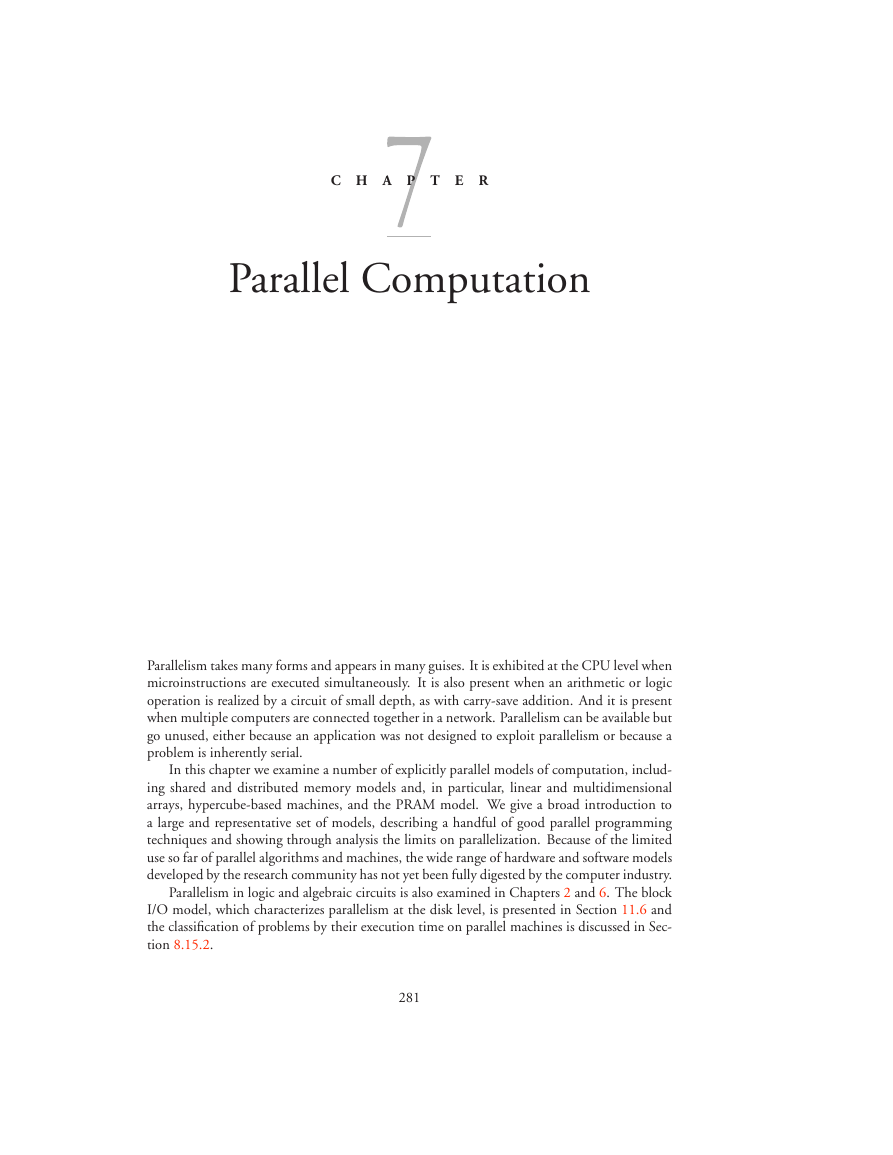
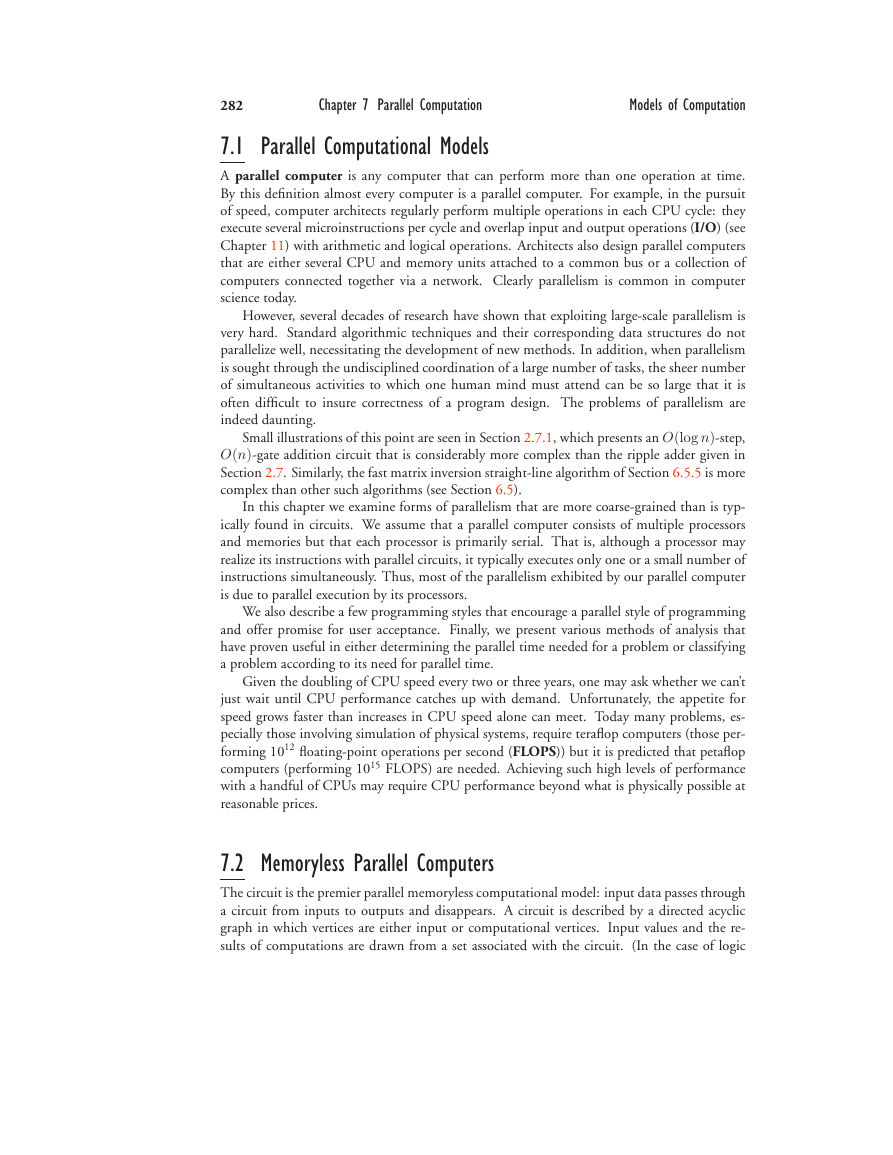
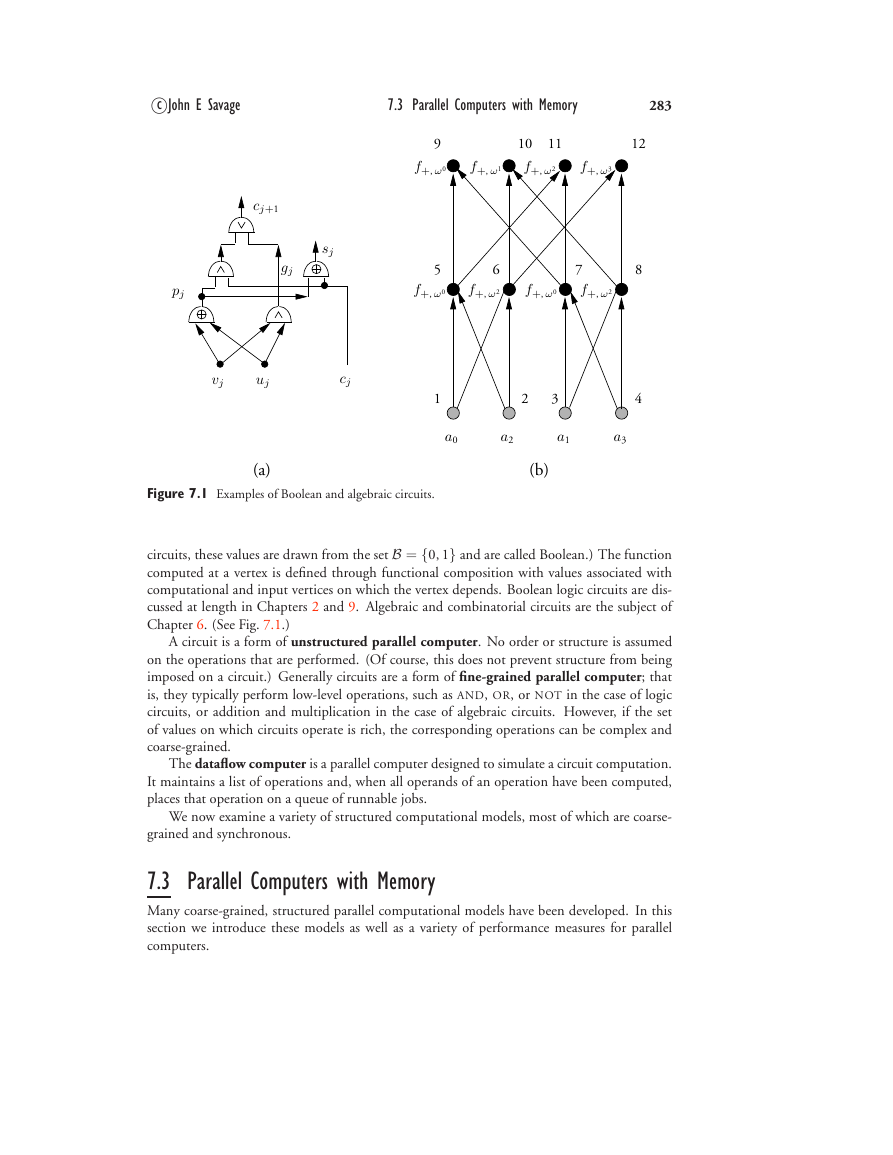
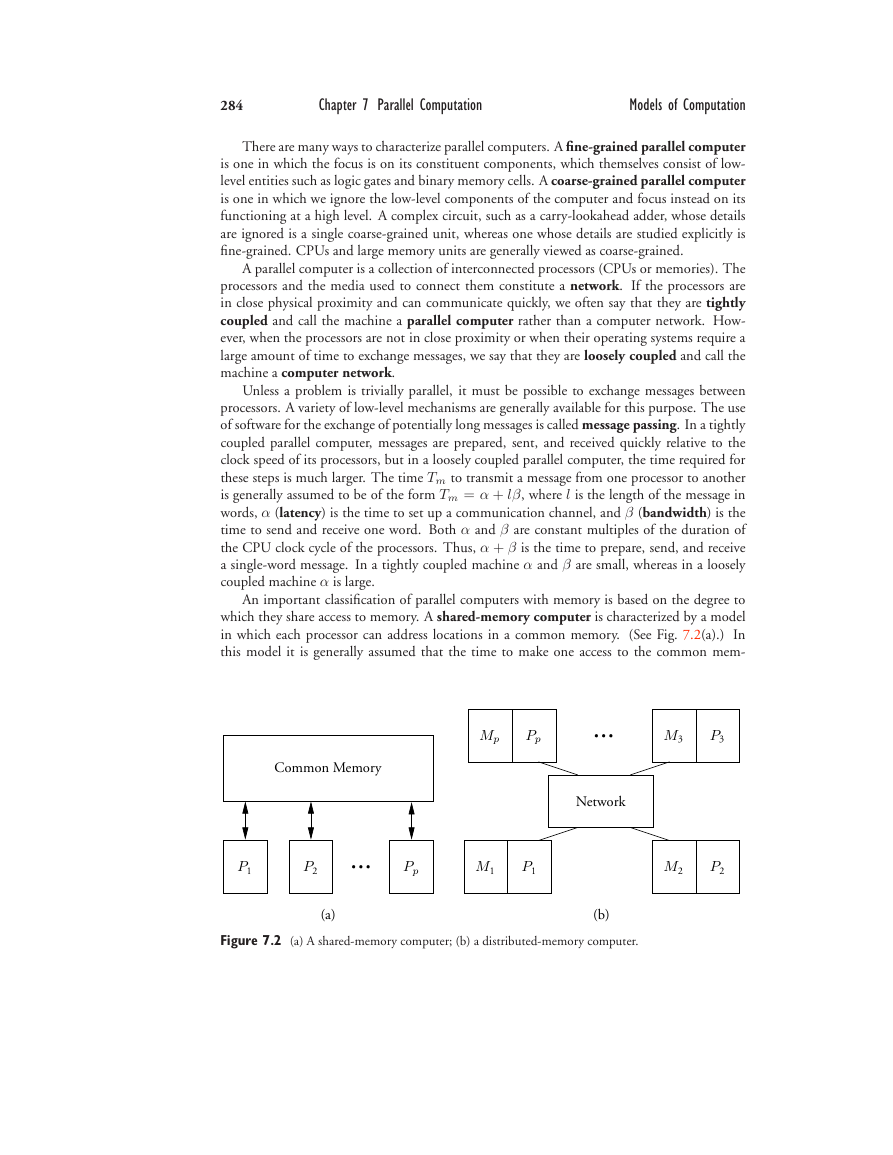
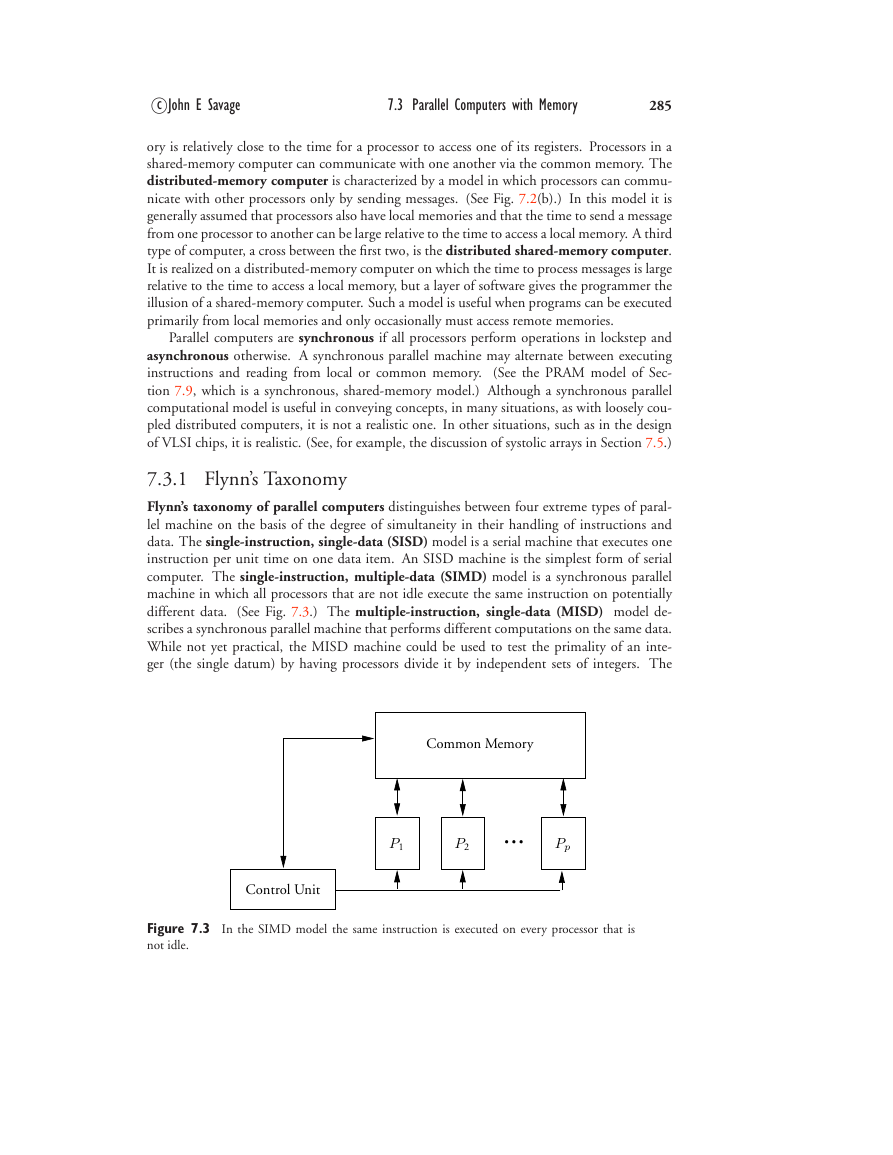
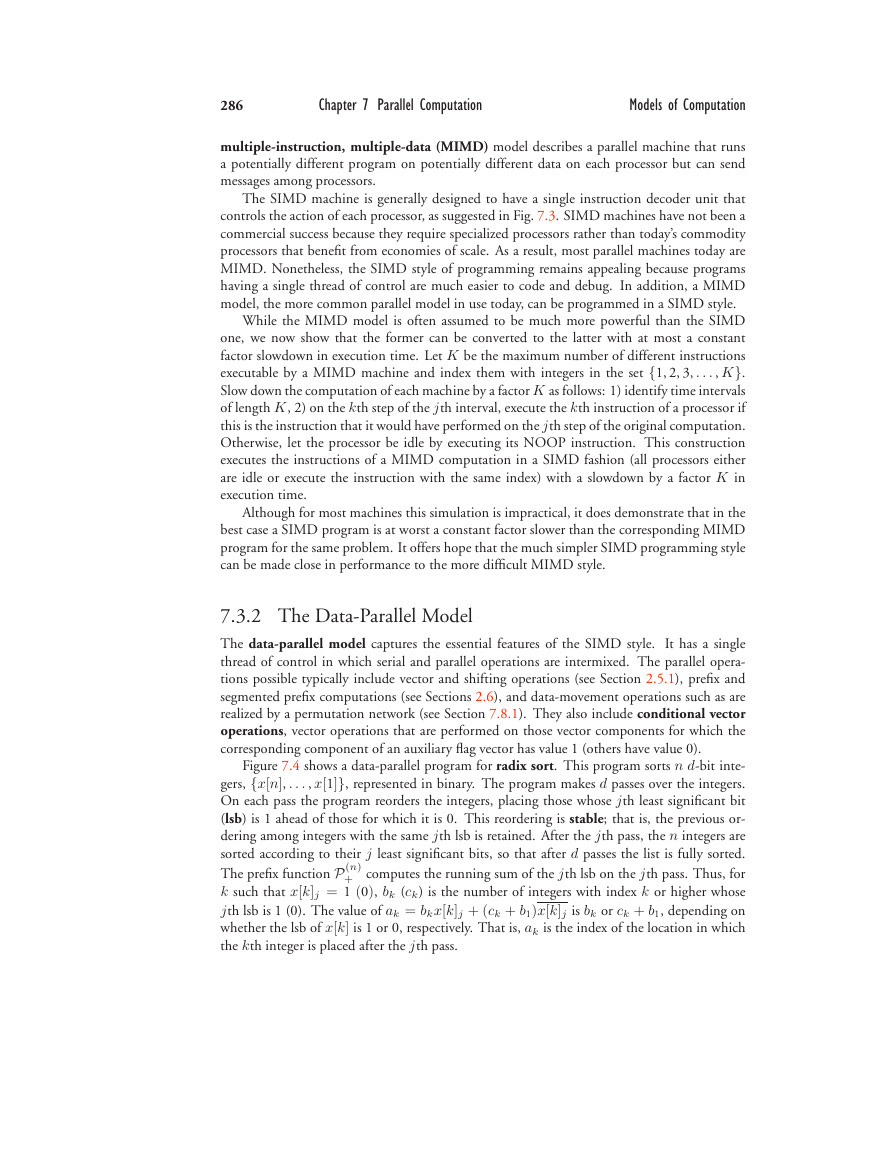
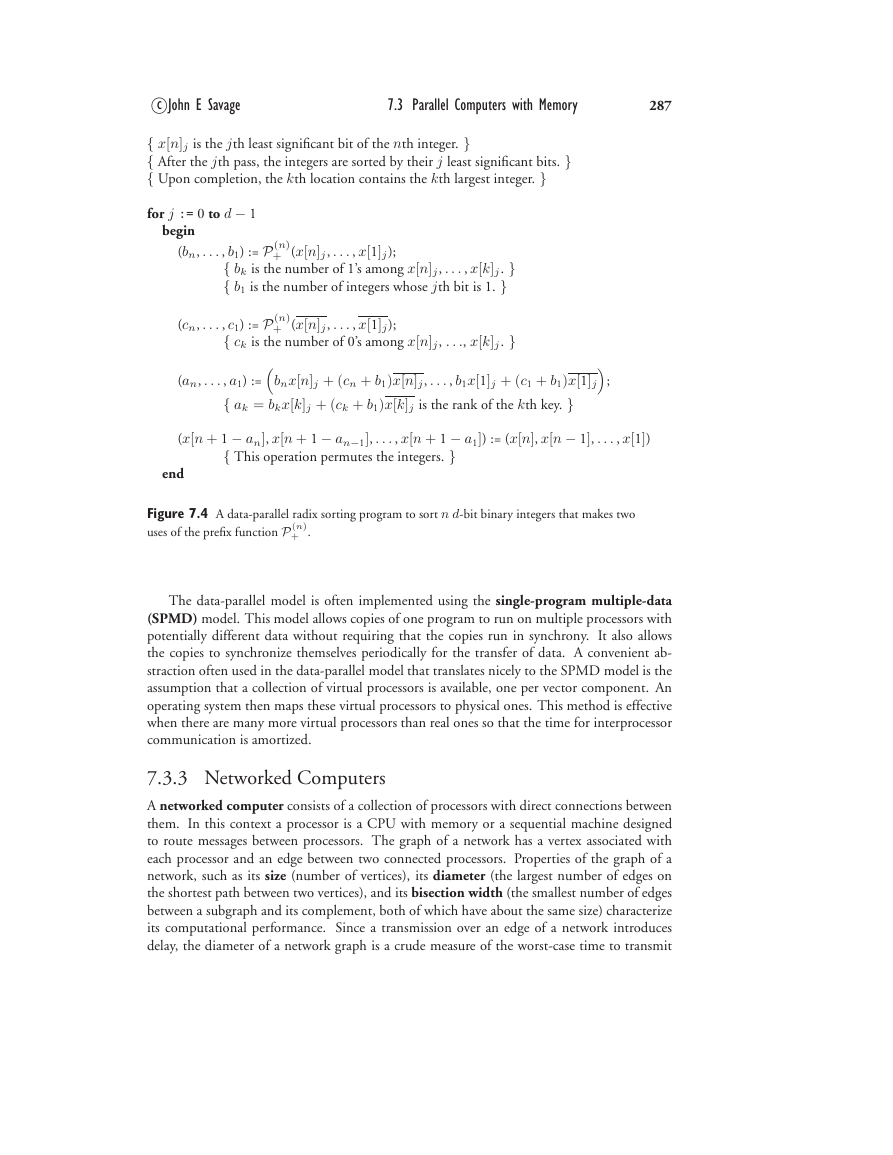
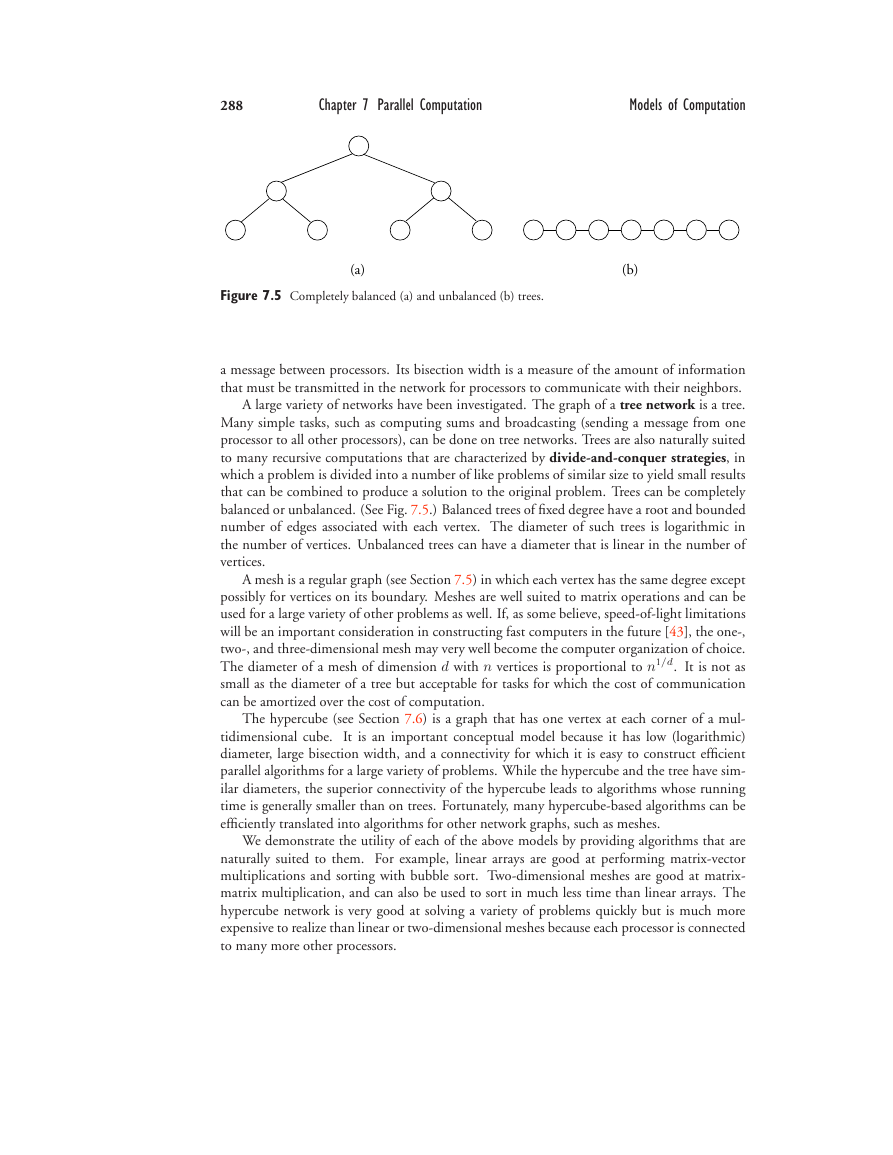








 2023年江西萍乡中考道德与法治真题及答案.doc
2023年江西萍乡中考道德与法治真题及答案.doc 2012年重庆南川中考生物真题及答案.doc
2012年重庆南川中考生物真题及答案.doc 2013年江西师范大学地理学综合及文艺理论基础考研真题.doc
2013年江西师范大学地理学综合及文艺理论基础考研真题.doc 2020年四川甘孜小升初语文真题及答案I卷.doc
2020年四川甘孜小升初语文真题及答案I卷.doc 2020年注册岩土工程师专业基础考试真题及答案.doc
2020年注册岩土工程师专业基础考试真题及答案.doc 2023-2024学年福建省厦门市九年级上学期数学月考试题及答案.doc
2023-2024学年福建省厦门市九年级上学期数学月考试题及答案.doc 2021-2022学年辽宁省沈阳市大东区九年级上学期语文期末试题及答案.doc
2021-2022学年辽宁省沈阳市大东区九年级上学期语文期末试题及答案.doc 2022-2023学年北京东城区初三第一学期物理期末试卷及答案.doc
2022-2023学年北京东城区初三第一学期物理期末试卷及答案.doc 2018上半年江西教师资格初中地理学科知识与教学能力真题及答案.doc
2018上半年江西教师资格初中地理学科知识与教学能力真题及答案.doc 2012年河北国家公务员申论考试真题及答案-省级.doc
2012年河北国家公务员申论考试真题及答案-省级.doc 2020-2021学年江苏省扬州市江都区邵樊片九年级上学期数学第一次质量检测试题及答案.doc
2020-2021学年江苏省扬州市江都区邵樊片九年级上学期数学第一次质量检测试题及答案.doc 2022下半年黑龙江教师资格证中学综合素质真题及答案.doc
2022下半年黑龙江教师资格证中学综合素质真题及答案.doc